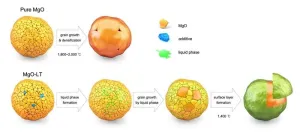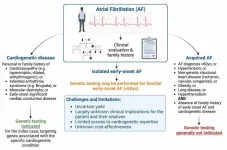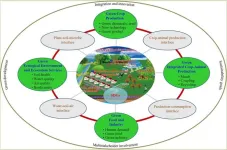(Press-News.org) Dogs’ sensitive noses can detect the early warning signs of many potentially dangerous medical situations, like an impending seizure or sudden hypoglycemia. Now, scientists have found evidence that assistance dogs might even be able to sniff out an oncoming PTSD flashback, by teaching two dogs to alert to the breath of people who have been reminded of traumas.
“PTSD service dogs are already trained to assist people during episodes of distress,” said Laura Kiiroja of Dalhousie University, first author of the paper in Frontiers in Allergy. “However, dogs are currently trained to respond to behavioral and physical cues. Our study showed that at least some dogs can also detect these episodes via breath.”
Stressed humans smell
PTSD arises from exposure to a catastrophic event: symptoms include re-experiencing that catastrophic event, hyperarousal, avoiding any reminders, and cognitive or mood issues. Among other forms of assistance, dogs can help patients by alerting to and interrupting episodes when their companions are struggling with their symptoms. If dogs could respond to stress markers on the breath, they could potentially interrupt episodes at an earlier stage, making their interventions more effective.
All humans have a ‘scent profile’ of volatile organic compounds (VOCs) — molecules emitted by the body in secretions like sweat — influenced by our genetics, age, activities, and other variables. There is some evidence that dogs may be capable of detecting VOCs linked to human stress. However, no studies have investigated whether dogs could learn to detect VOCs associated with PTSD symptoms.
“This is a multidisciplinary collaboration between Dr Sherry Stewart’s clinical psychology lab and Dr Simon Gadbois’ canine olfaction lab, both at Dalhousie University,” said Kiiroja. “Neither lab could have done this work on their own. We brought together two distinct sets of expertise.”
Catching the scent
The scientists recruited 26 humans as scent donors. These participants were also taking part in a study about the reactions of people who have experienced trauma to reminders of that trauma; 54% met the diagnostic requirements for PTSD. To donate scents, they attended sessions where they were reminded of their trauma experiences while wearing different facemasks. One facemask provided a calm breath sample that acted as the control, and another, which was worn while the participants recalled their trauma, provided a target breath sample. Participants also completed a questionnaire about their stress levels and their emotions.
In the meantime, the scientists recruited 25 pet dogs to train in scent-detection. Only two were skilled and motivated enough to complete the study: Ivy and Callie.
“Both Ivy and Callie found this work inherently motivating,” said Kiiroja. “Their limitless appetite for delicious treats was also an asset. In fact, it was much harder to convince them to take a break than to commence work. Callie in particular made sure there was no dilly-dallying.”
Ivy and Callie were trained to recognize the target odor from pieces of the facemasks, achieving 90% accuracy in discriminating between a stressed and a non-stressed sample. They were then presented with a series of samples, one sample at a time, to see if they could still accurately detect the stress VOCs. In this second experiment, Ivy achieved 74% accuracy and Callie achieved 81% accuracy.
Humans’ best friend
Comparing Callie and Ivy’s successful identifications with the human participants’ self-reported emotions revealed that Ivy’s performance correlated with anxiety, whereas Callie’s correlated with shame.
“Although both dogs performed at very high accuracy, they seemed to have a slightly different idea of what they considered a ‘stressed’ breath sample,” said Kiiroja. “We speculated that Ivy was attuned to sympathetic-adreno-medullar axis hormones (like adrenaline) and Callie was oriented to the hypothalamo-pituitary-adrenal axis hormones (like cortisol). This is important knowledge for training service dogs, as alerting to early-onset PTSD symptoms requires sensitivity to sympathetic-adreno-medullar axis hormones.”
Next, the team plans to carry out experiments to confirm the involvement of the sympathetic-adreno-medullar axis.
“With 40 sample sets, ours is a proof-of-concept study that needs to be validated by studies with larger sample sizes,” cautioned Kiiroja. “In addition to enrolling more participants, validation studies should collect samples from a higher number of stressful events to confirm dogs’ ability to reliably detect stress VOCs in the breath of one human across different contexts.”
END
Dogs trained to detect trauma stress by smelling humans’ breath
A pilot study shows that dogs can be taught to recognize the scent of trauma reactions on the breath, which could make PTSD assistance dogs more effective
2024-03-28
ELSE PRESS RELEASES FROM THIS DATE:
Electronic device thermal management made simpler and slightly better!
2024-03-28
Dr. Cheol-Woo Ahn, leading a research team at the Department of Functional Ceramics within the Ceramic Materials Division at the Korea Institute of Materials Science(KIMS), has developed the world's first heat dissipation material. This material reduces hydrophilicity through a chemical reaction that forms a nanocrystalline composite layer and increases thermal conductivity by controlling point defects. This process occurs during a simple sintering process that does not require surface treatment. KIMS is a government-funded research institute under the Ministry of Science and ICT.
Conventional ...
Study: Dangerous surgical site infections can be reduced with simple prevention protocol
2024-03-28
Arlington, Va. — March 28, 2024 — A new study published today in the American Journal of Infection Control (AJIC) demonstrates the use of a simple pre-surgical infection prevention protocol to prevent dangerous post-surgical infections. Researchers performed this investigation at the Soroka University Medical Center in Israel.
Surgical site infections (SSIs) are a type of healthcare-associated infection with deadly consequences for some patients. According to the latest data from the Centers for ...
Genetic testing of patients with atrial fibrillation can alert clinicians to potential development of life-threatening conditions
2024-03-28
Philadelphia, March 28, 2024 – Although the vast majority of clinicians do not view atrial fibrillation (AF) as a genetic disorder, a White Paper in the Canadian Journal of Cardiology, published by Elsevier, analyzes the current understanding of genetics and the role of genetic testing in AF and concludes there is an increasing appreciation that genetic culprits for potentially life-threatening ventricular cardiomyopathies and channelopathies may initially present with AF.
AF is the most common sustained cardiac arrhythmia and is associated with increased risks of heart failure, stroke, and death. It is ...
Artificial Intelligence tool successfully predicts fatal heart rhythm
2024-03-28
In a Leicester study that looked at whether artificial intelligence (AI) can be used to predict whether a person was at risk of a lethal heart rhythm, an AI tool correctly identified the condition 80 per cent of the time.
The findings of the study, led by Dr Joseph Barker working with Professor Andre Ng, Professor of Cardiac Electrophysiology and Head of Department of Cardiovascular Sciences at the University of Leicester and Consultant Cardiologist at the University Hospitals of Leicester NHS Trust, have been published in the European Heart Journal – Digital Health.
Ventricular arrhythmia (VA) is a heart rhythm disturbance originating from the bottom chambers (ventricles) where ...
What progress has China made in agriculture green development over the past five years?
2024-03-28
Reconciling the tasks of producing adequate amounts of nutritious food for the increasing global population while preserving the environment and natural ecosystems simultaneously is an enormous challenge. The concept of agriculture green development (AGD) was detailed in 2017 and the necessary governmental policies were developed to address the aforementioned challenge in China and to help achieve the related global sustainable development goals. AGD emphasizes the synergy between green and development; current agriculture has to transform from the intensive farming with high inputs, high environmental impacts ...
ALMA finds new molecular signposts in starburst galaxy
2024-03-28
The ALMA radio telescope has detected more than 100 molecular species, including many indicative of different star formation and evolution processes, in a galaxy where stars are forming much more actively than in the Milky Way. This is far more molecules than were found in previous studies. Now the team will try to apply this knowledge to other galaxies.
A team of researchers led by Sergio Martin of the European Southern Observatory/Joint ALMA Observatory, Nanase Harada of the National Astronomical Observatory of Japan, and Jeff Mangum of the National Radio Astronomy Observatory ...
Open waste burning linked to air pollution in Northwestern Greenland
2024-03-28
A case study on the effects of open waste burning on air quality in Northwestern Greenland calls attention to the importance of no-one-left-behind sustainable air quality monitoring in the Arctic region.
To better understand the air quality risks faced by remote Arctic communities, an international team monitored aerial pollutants at a community in Northwestern Greenland. Their findings, published in Atmospheric Science Letters, reveal that open waste burning elevates the concern of health risks to the community.
The study focused on Qaanaaq, a small village in Northwestern Greenland with a population of approximately 600. During the summer of 2022, the team conducted the first-time measurement ...
Google Street View reveals how built environment correlates with risk of cardiovascular disease
2024-03-28
Researchers have used Google Street View to study hundreds of elements of the built environment, including buildings, green spaces, pavements and roads, and how these elements relate to each other and influence coronary artery disease in people living in these neighbourhoods.
Their findings, published in the European Heart Journal [1] today (Thursday), show that these factors can predict 63% of the variation in the risk of coronary heart disease from one area to another.
Coronary heart disease, where a build-up of fatty substances in the coronary arteries ...
Connecting the dots to shape growth forces
2024-03-28
Kyoto, Japan -- Branching patterns are prevalent in our natural environment and the human body, such as in the lungs and kidneys. For example, specific genes that express growth factor proteins are known to influence the development of the lungs' complex branches. Still, until now the mechanics behind this phenomenon have remained a mystery.
Kyoto University researchers have unveiled a regulatory system linking signal, force, and shape in mouse lung structure development. The team recognized that the signal protein ERK plays an active role in causing growing lung tissue to curve.
"ERK signals the cell tissue to stretch outward to smoothen its ...
Parental avoidance of toxic exposures could help prevent autism, ADHD in children, new study shows
2024-03-28
SAN ANTONIO, March 27, 2024 – Autism and attention deficit hyperactivity disorder (ADHD) may be preventable if parents avoid toxic exposures and adopt interventions such as environmental house calls, according to a published study led by researchers from The University of Texas Health Science Center at San Antonio (UT Health San Antonio).
Using a validated, self-administered questionnaire now used worldwide to identify individuals with chemical intolerance – the Quick Environmental ...
LAST 30 PRESS RELEASES:
When is it time to jump? The boiling frog problem of AI use in physics education
Twitter data reveals partisan divide in understanding why pollen season's getting worse
AI is quick but risky for updating old software
Revolutionizing biosecurity: new multi-omics framework to transform invasive species management
From ancient herb to modern medicine: new review unveils the multi-targeted healing potential of Borago officinalis
Building a global scientific community: Biological Diversity Journal announces dual recruitment of Editorial Board and Youth Editorial Board members
Microbes that break down antibiotics help protect ecosystems under drug pollution
Smart biochar that remembers pollutants offers a new way to clean water and recycle biomass
Rice genes matter more than domestication in shaping plant microbiomes
Ticking time bomb: Some farmers report as many as 70 tick encounters over a 6-month period
Turning garden and crop waste into plastics
Scientists discover ‘platypus galaxies’ in the early universe
Seeing thyroid cancer in a new light: when AI meets label-free imaging in the operating room
Neutrophil-to-lymphocyte ratio may aid risk stratification in depressive disorder
2026 Seismological Society of America Annual Meeting
AI-powered ECG analysis offers promising path for early detection of chronic obstructive pulmonary disease, says Mount Sinai researchers
GIMM uncovers flaws in lab-grown heart cells and paves the way for improved treatments
Cracking the evolutionary code of sleep
Medications could help the aging brain cope with surgery, memory impairment
Back pain linked to worse sleep years later in men over 65, according to study
CDC urges ‘shared decision-making’ on some childhood vaccines; many unclear about what that means
New research finds that an ‘equal treatment’ approach to economic opportunity advertising can backfire
Researchers create shape-shifting, self-navigating microparticles
Science army mobilizes to map US soil microbiome
Researchers develop new tools to turn grain crops into biosensors
Do supervised consumption sites bring increased crime? Study suggests that’s a myth
New mass spec innovation could transform research
Maternal nativity, race, and ethnicity and infant mortality in the US
Migration-related trauma among asylum seekers exposed to the migrant protection protocols
Jupiter’s moon Europa has a seafloor that may be quiet and lifeless
[Press-News.org] Dogs trained to detect trauma stress by smelling humans’ breathA pilot study shows that dogs can be taught to recognize the scent of trauma reactions on the breath, which could make PTSD assistance dogs more effective






